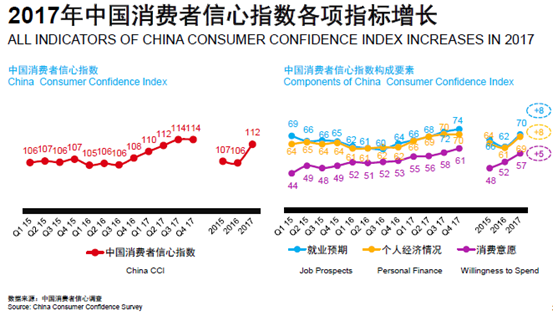
Chinese prefer a slower pace when traveling and were a factor behind the CCI rise, on February 6, 2018. Photo: AP

Consumer confidence idexes for 2017 reached new levels not seen in three years. Photo: Nielsen
China’s Consumer Confidence Index (CCI) finished at 112 points on average for 2017, an increase of six points compared with 2016, indicating strong consumer confidence, optimism, and positive attitudes, a recent study said on Tuesday.
Q4 earnings for 2017 saw CCI hit 114 points, continuing its historic ascent. The figure was up six points from 108 in the same period year on year, according to Nielsen, a global performance management company.
The surging CCI is attributed to three driving forces: consumer optimism on local job prospects, healthy personal finances, and immediate spending intentions.
Last year, both job prospects (jumping from 62 to 70 percent) and personal finance (growing from 61 to 69 percent) achieved 8-point growth.
The willingness to spend increased from 52 to 57 percent, a 5-point jump from 2016.
All category indexes reached their highest levels since 2015.
Consumer confidence levels above and below a baseline of 100 indicate degrees of optimism and pessimism.
“For the past four years, China's domestic consumption has become a leading force driving economic growth thanks to government efforts to restructure the economy,” said Vishal Bali, managing director of Nielsen China.
The new study shows that low-tier cities are experiencing faster growth due to the overall CCI rise.
The full penetration of industrial upgrading and an increased tempo of life has stimulated the economic development in lower-tier cities.
"China's economy has been shifting from a growth model driven by large volume to a model fueled by quality and efficiency. It entered a new stage of ‘steady growth with improved quality’,” said Bali.
Fast pace goes mainstream
The Nielsen study found that as China’s urbanization speeds up, the fast pace of its big cities is the standard.
Chinese cities are developing rapidly with people facing an intensive workload.
Consumers demand instant delivery and better fast food. The fast pace has also led to the rapid adoption of digital technology.
The report shows 96 percent of Chinese consumers are willing to use mobile payments, compared with 65 percent in the US.
Right now new retain concepts are widely embraced in China.
Office vending machines have become popular since the beginning of Q3 2017.
China’s Fast Moving Consumer Goods (FMCG) market shows strong innovation capability with contributions from new products.
Consumers prefer traveling and dining slowly
In a fast-paced life, travel demand continues to rise.
A growing number of consumers prefer a slower pace when traveling. The fever for traveling has no restriction on age and gender.
It’s noteworthy that people born in the 1990’s prefer individual travel rather than the tour groups their parents are accustomed to using.
Enjoying fine cuisine is also one of the choices that consumers make to "slow down." Not only have consumers expressed a willingness to wait for delicious food, but also enjoy eating their daily meals at a slower pace.
At the same time, consumers are keen on searching for information about food that takes longer to prepare.
Those born after 1995 tend to consider themselves foodies, and drive local trends such as imported and limited edition edibles, and “hidden menus.”
“Enterprises should get to know the changes in consumer demand quickly, grasp fresh opportunities, and create new growth space,” Bali noted.
Chinese CCI will remain steady
According to Nielsen, the Chinese economy showed a positive trend in both macro and micro perspectives.
It is expected the CCI will continue to maintain its high level in 2018, given the steady growth of the economy and employment.
The economic structure has undergone a positive transformation, and the growth momentum has been shifting to a steady pace.
These factors combined help establish a solid foundation for China’s ongoing steady growth with high-quality development.
“China is leading in so many things, such as the digital economy, AI, driverless cars, and so on. The world can learn a lot from China,” said Bali.


